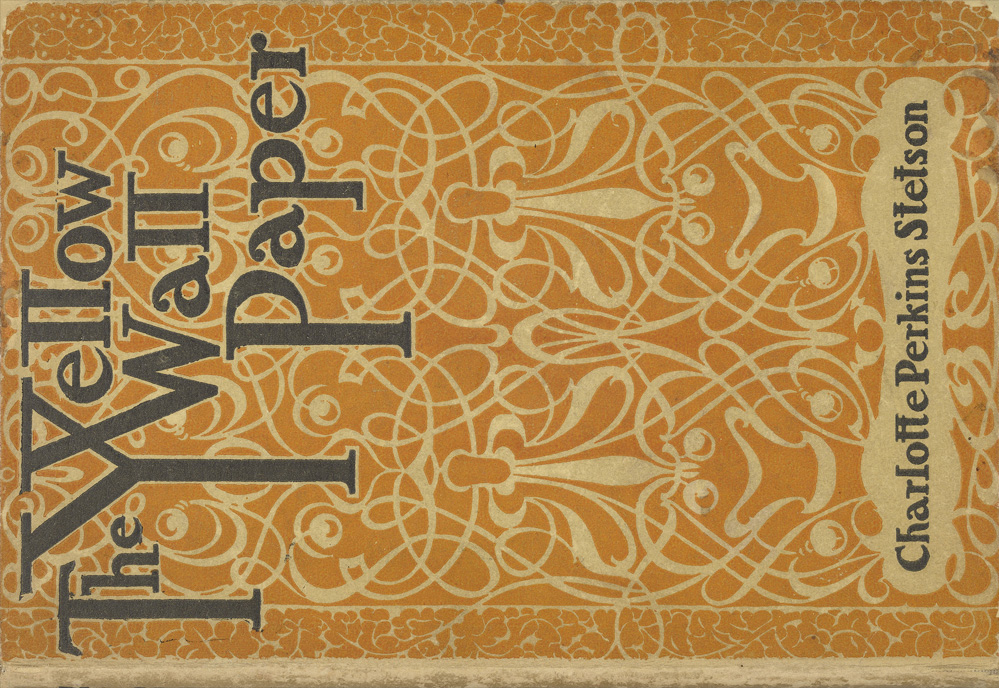The Yellow Wallpaper (1892) by Charlotte Perkins Gilman is a short story about a woman’s descent into madness because her doctor husband downplays her mental illness. The story is also an ideal illustration of the 19th century society’s view of mental illness, and clear criticism of the rest cure that was often administered to patients with mental illness.
From a feminist literature perspective, Gilman shows how the lack of self-agency that characterized a woman’s life during the Victorian era was harmful. This literary analysis essay explores mental health and agency as the main themes in Charlotte Perkins’ The Yellow paper and how they intersect to create an ending that can be viewed as mental breakdown and mental freedom at the same time.
‘The Yellow Wallpaper’ Plot Summary
The Yellow Wallpaper is narrated in the form of diary entries. The narrator and main character, a woman, gives readers a glimpse into a three-months stay at an ancestral home for the summer, including her declining mental health. She’s staying here with her husband John, her young baby, her husband’s sister Jane, and Mary the help.
First, she gives a description of the house and its peculiarities, which her husband laughs at and often dismisses. In fact, he does not believe that she’s sick. He believes that she’s suffering from a mere “temporary nervous depression—a slight hysterical tendency.” The narrator is not allowed to carry out any form of work, including writing, which is her favorite pastime activity. She disagrees with this advice but there’s nothing she can do besides write when no one can see her.
The narrator then continues to describe the house, including the upper nursery room in which they’ll be staying. She wants to stay in the room downstairs which opens up to a piazza, but John insists that the open air upstairs will do her good. The floor is “scratched and gouged and splintered,” with only one old bed that’s nailed to the floor and looks like it has “been through the wars.” The room also has an ugly and eerie yellow wallpaper that the narrator takes an obsessive interest in. Sometimes she can see a “strange, provoking, formless sort of figure” lurking behind the front design of the wallpaper that looks like bars.
Time passes. The narrator and her husband have hosted their family for the fourth of July celebrations and the two have stayed here for a while now but she doesn’t seem to be getting better. She’s been feeling exhausted despite the enforced naps, and the yellow wallpaper doesn’t make things any better. She has also determined that the strange formless figure behind the wallpaper design is “like a woman stooping down and creeping about behind that pattern.” She wants to leave and go back home but her husband won’t let her. He insists that she’s getting better and after all, their lease expires after three weeks only.
So in the remaining weeks, the narrator becomes increasingly obsessed with the yellow wallpaper and is even getting better because of it. She’s now certain that the dim sub-pattern behind the front design is a woman (sometimes women) who creeps and crawls behind the pattern, making it seem like she’s shaking the bars. Determined to free the woman behind the pattern, the narrator waits until her husband is out on the last day, locks herself in the nursery, and begins to tear off the wallpaper. When John comes into the room and finds the narrator creeping, he’s so shocked that he faints but the woman continues crawling and creeping over her husband’s body.
Literary Analysis: Themes In Charlotte Gilman’s ‘The Yellow Wallpaper’
Gilman explores several themes in her short story The Yellow Wallpaper but two of them stand out more than the rest: mental health and the importance of self-expression or self-agency.
Mental Health as a Theme in ‘The Yellow Wallpaper’
The narrator suffers from a mental condition, though her husband refers to it as a mere hysterical tendency. Since she has an infant, it’s safe to allude that she’s suffering from postpartum depression. The Yellow Wallpaper sheds light on society’s perception of mental health at that time, remedies, and the general view of patients, especially women.
Due to limited scientific studies and resources, mental illnesses were not well studied or understood during the Victorian era. People with mental health conditions, ranging from mild depression to serious manic episodes were viewed as an inconvenience to society. A slight behavioral or emotional deviation from the norm was enough to be declared insane, especially for women. Physicians who treated these conditions were referred to as alienists because of the nature of their work. What’s termed as depression today was known as melancholia in this era. The symptoms included, insomnia, lack of appetite, suicidal thoughts, a need to isolate oneself, fear, gloom, and quietness. Medical practitioners later began categorizing melancholy based on the symptoms, which made treatment easier, but were still unclear on what caused the condition.
Treatments for mental health illnesses were still in development and unfortunately, they were tested on patients. They included heavy medication dosages, such as morphine and arsenic, as well as being committed to mad houses and asylums. Other popular remedies included surgeries, taking alcohol with every meal, oppressive shower baths, and Weir Mitchell’s rest cure, which was mostly administered on women. Unfortunately, these remedies were not effective and only served to numb the symptoms. Some even made the conditions worse as are the allegations in the case of King George III’s insanity.
In The Yellow Wallpaper, the young woman suffers from a mental condition that’s likely postpartum depression. Her husband, who’s ironically a doctor, worsens her condition by ignoring her symptoms and terming them as mere hysterical tendencies. Due to the patriarchal nature of society back then, medical misogyny was a commonplace and was often harmful to women’s health. In this story, a husband and the woman’s brother (who are all doctors) do not believe she’s sick, despite her feeling and saying otherwise.
“You see, he does not believe I am sick! …Personally, I disagree with their ideas.
Personally, I believe that congenial work, with excitement and change, would do me good. But what is one to do?”
Her feelings of helplessness and lack of self-agency on what to do about her health is influenced by the lack of freedom and self-expression that characterized women’s lives during this time.
The woman in the story is on prescribed rest cure. The main characteristics of rest cure for women in the Victorian era involved seclusion, enforced bed rest, overfeeding, and staying away from stimulating activities such as writing or one’s profession. Interestingly, Weir Mitchell had a different regimen for men’s rest cure to treat nervousness, which involved trips to the West wilderness, physical activities, creative endeavors, hunting, and male bonding. As expected, female patients continued to get worse while male patients came back healed, well rested, and more empowered.
The woman’s mental condition in The Yellow Wallpaper continues to worsen despite the prescribed rest. Her illness gets so much worse that by the end of the story, she has become one with her condition. Writing down in her diary seems to calm her nervousness but even then she has to do it hiding lest her husband or sister in law discovers and takes it away from her. The story’s ending can be interpreted as liberation from society, John’s rules, and the woman’s mind. But what’s clear is the effects of stifled self-expression especially on women during the Victorian era.
The Yellow Wallpaper and Charlotte Gilman’s Mental Illness
Gilman suffered postpartum depression in real life and underwent a rest cure as prescribed by Weir Mitchell. She claims that the treatment only made her worse because she was in mental agony throughout the period. Most readers, therefore, view The Yellow Wallpaper as a form of fictional criticism for the rest cure approach. Gilman improved after she started reading and writing about her condition.
Stuck on your literary analysis essay, book review, or summary? Get an original, customized, and 100% human-written academic essay from an avid reader. Get in touch with me to learn how I can help you!




Pingback: 3 Feminist Short Stories That you will Absolutely Love